GGBS Concrete Strength Development and Durability Analysis Report
VerifiedAdded on 2023/01/12
|43
|10571
|47
Report
AI Summary
This report critically evaluates the strength development of Ground Granulated Blast Furnace Slag (GGBS) concrete under normal curing conditions. It highlights the slower strength development of GGBS concrete compared to Portland cement concrete, making it less popular for fast-track construction, but emphasizes its environmental friendliness, durability, and economic sustainability. The study uses three concrete mixes with varying GGBS cement levels (0-50% replacement) and a water-binder ratio of 0.5. Results show improved early-age strength development with 25% and 50% GGBS replacement. The report analyzes experimental results, concluding that GGBS concrete strength is highly dependent on curing temperature, water-binder ratio, and GGBS replacement level. It includes a literature review on GGBS's historical use and its effects on concrete properties such as permeability, carbonation, and sulfate resistance. The report also details materials, methods, results, and discussions, providing a comprehensive analysis of GGBS concrete's performance and potential for sustainable construction practices.

Report
Paraphrase This Document
Need a fresh take? Get an instant paraphrase of this document with our AI Paraphraser

Page 2
Abstract
This study has demonstrated that, the strength development of the GGBS concrete has been critically evaluated
under the normal curing conditions. It has been interpreted that, the GGBS concrete is not popular within the
fast track construction because of the slower strength development. The key benefit associated with the GGBS
is linked with the environmental friendliness, durability, economic sustainability, etc.
Within the current study, 3 concrete mixes have been used which evaluates that, strength development of the
GGBS has been determined by various levels of the GGBS cement which in turn range from 0 to 50%. The
water binded ratio was estimated to be 0.5 within concrete in winters. The early age development of the
strength of 25% and 50% GGBS replacement tends to have high degree of improvement within the
development of the strength.
The key results which in turn has been obtained from the experiments in turn has been analyzed in order to
suggest that, the development of the strength of GBBS concrete is slower when compared with the Portland
cement concrete. The development of the strength of GBBS is highly dependent on the curing temperature,
water binder ratio and degree or level of replacement of GBBS.
Abstract
This study has demonstrated that, the strength development of the GGBS concrete has been critically evaluated
under the normal curing conditions. It has been interpreted that, the GGBS concrete is not popular within the
fast track construction because of the slower strength development. The key benefit associated with the GGBS
is linked with the environmental friendliness, durability, economic sustainability, etc.
Within the current study, 3 concrete mixes have been used which evaluates that, strength development of the
GGBS has been determined by various levels of the GGBS cement which in turn range from 0 to 50%. The
water binded ratio was estimated to be 0.5 within concrete in winters. The early age development of the
strength of 25% and 50% GGBS replacement tends to have high degree of improvement within the
development of the strength.
The key results which in turn has been obtained from the experiments in turn has been analyzed in order to
suggest that, the development of the strength of GBBS concrete is slower when compared with the Portland
cement concrete. The development of the strength of GBBS is highly dependent on the curing temperature,
water binder ratio and degree or level of replacement of GBBS.

Page 3
Contents
Abstract....................................................................................................................................................
CHAPTER 1: INTRODUCTION............................................................................................................
Chapter 2: Literature review....................................................................................................................
2.1 Historical use of GGBS.................................................................................................................7
2.2 The effect of GGBS on the durability of Concrete.......................................................................8
2.2.1 Premeability..............................................................................................................................8
2.2.2 Carbonation..............................................................................................................................8
2.2.3 Suplhate resistance...................................................................................................................9
2.2.4 Chloride.....................................................................................................................................9
2.3 the effects of GGBS upon physical properties of Concrete..........................................................9
2.4 GGBS effect on chemical Properties of concrete:......................................................................10
................................................................................................................................................................11
CHAPTER 3: MATERIALS AND METHODS....................................................................................18
3.1.1 Concrete Casting and Curing:.................................................................................................21
3.2.6 Testing, procedures and equipment:.............................................................................................23
Equipment’s:............................................................................................................................23
Equipment’s:............................................................................................................................25
CHAPTER 4: RESULTS AND DISCUSSION.....................................................................................26
CHAPTER 5: CONCLUSIONS............................................................................................................30
Chapter 6: Recommendation for carrying out future study....................................................................32
REFERENCES.......................................................................................................................................34
Chapter 8 Appendences..........................................................................................................................38
Contents
Abstract....................................................................................................................................................
CHAPTER 1: INTRODUCTION............................................................................................................
Chapter 2: Literature review....................................................................................................................
2.1 Historical use of GGBS.................................................................................................................7
2.2 The effect of GGBS on the durability of Concrete.......................................................................8
2.2.1 Premeability..............................................................................................................................8
2.2.2 Carbonation..............................................................................................................................8
2.2.3 Suplhate resistance...................................................................................................................9
2.2.4 Chloride.....................................................................................................................................9
2.3 the effects of GGBS upon physical properties of Concrete..........................................................9
2.4 GGBS effect on chemical Properties of concrete:......................................................................10
................................................................................................................................................................11
CHAPTER 3: MATERIALS AND METHODS....................................................................................18
3.1.1 Concrete Casting and Curing:.................................................................................................21
3.2.6 Testing, procedures and equipment:.............................................................................................23
Equipment’s:............................................................................................................................23
Equipment’s:............................................................................................................................25
CHAPTER 4: RESULTS AND DISCUSSION.....................................................................................26
CHAPTER 5: CONCLUSIONS............................................................................................................30
Chapter 6: Recommendation for carrying out future study....................................................................32
REFERENCES.......................................................................................................................................34
Chapter 8 Appendences..........................................................................................................................38
⊘ This is a preview!⊘
Do you want full access?
Subscribe today to unlock all pages.

Trusted by 1+ million students worldwide

Page 4
Paraphrase This Document
Need a fresh take? Get an instant paraphrase of this document with our AI Paraphraser
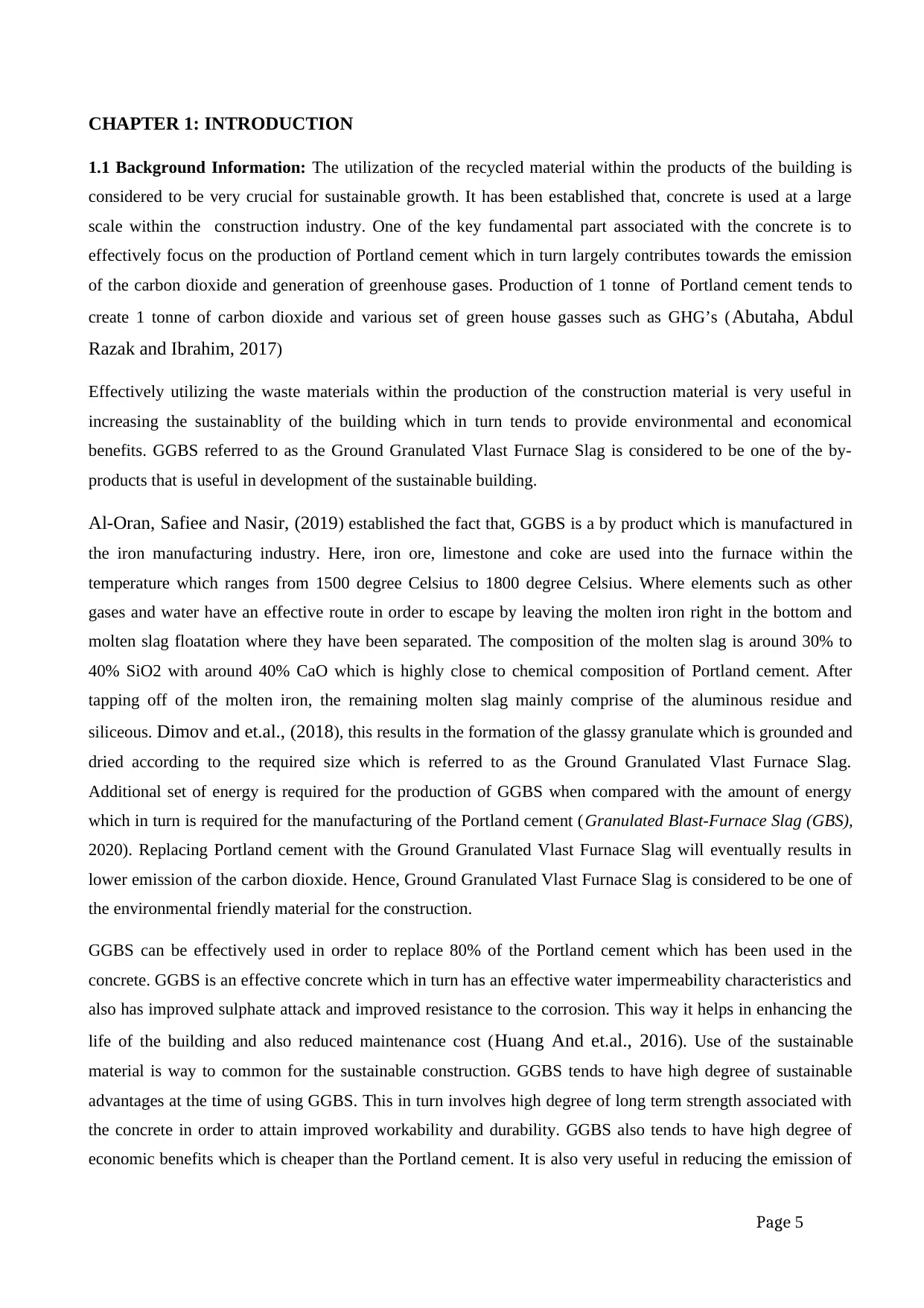
Page 5
CHAPTER 1: INTRODUCTION
1.1 Background Information: The utilization of the recycled material within the products of the building is
considered to be very crucial for sustainable growth. It has been established that, concrete is used at a large
scale within the construction industry. One of the key fundamental part associated with the concrete is to
effectively focus on the production of Portland cement which in turn largely contributes towards the emission
of the carbon dioxide and generation of greenhouse gases. Production of 1 tonne of Portland cement tends to
create 1 tonne of carbon dioxide and various set of green house gasses such as GHG’s (Abutaha, Abdul
Razak and Ibrahim, 2017)
Effectively utilizing the waste materials within the production of the construction material is very useful in
increasing the sustainablity of the building which in turn tends to provide environmental and economical
benefits. GGBS referred to as the Ground Granulated Vlast Furnace Slag is considered to be one of the by-
products that is useful in development of the sustainable building.
Al-Oran, Safiee and Nasir, (2019) established the fact that, GGBS is a by product which is manufactured in
the iron manufacturing industry. Here, iron ore, limestone and coke are used into the furnace within the
temperature which ranges from 1500 degree Celsius to 1800 degree Celsius. Where elements such as other
gases and water have an effective route in order to escape by leaving the molten iron right in the bottom and
molten slag floatation where they have been separated. The composition of the molten slag is around 30% to
40% SiO2 with around 40% CaO which is highly close to chemical composition of Portland cement. After
tapping off of the molten iron, the remaining molten slag mainly comprise of the aluminous residue and
siliceous. Dimov and et.al., (2018), this results in the formation of the glassy granulate which is grounded and
dried according to the required size which is referred to as the Ground Granulated Vlast Furnace Slag.
Additional set of energy is required for the production of GGBS when compared with the amount of energy
which in turn is required for the manufacturing of the Portland cement (Granulated Blast-Furnace Slag (GBS),
2020). Replacing Portland cement with the Ground Granulated Vlast Furnace Slag will eventually results in
lower emission of the carbon dioxide. Hence, Ground Granulated Vlast Furnace Slag is considered to be one of
the environmental friendly material for the construction.
GGBS can be effectively used in order to replace 80% of the Portland cement which has been used in the
concrete. GGBS is an effective concrete which in turn has an effective water impermeability characteristics and
also has improved sulphate attack and improved resistance to the corrosion. This way it helps in enhancing the
life of the building and also reduced maintenance cost (Huang And et.al., 2016). Use of the sustainable
material is way to common for the sustainable construction. GGBS tends to have high degree of sustainable
advantages at the time of using GGBS. This in turn involves high degree of long term strength associated with
the concrete in order to attain improved workability and durability. GGBS also tends to have high degree of
economic benefits which is cheaper than the Portland cement. It is also very useful in reducing the emission of
CHAPTER 1: INTRODUCTION
1.1 Background Information: The utilization of the recycled material within the products of the building is
considered to be very crucial for sustainable growth. It has been established that, concrete is used at a large
scale within the construction industry. One of the key fundamental part associated with the concrete is to
effectively focus on the production of Portland cement which in turn largely contributes towards the emission
of the carbon dioxide and generation of greenhouse gases. Production of 1 tonne of Portland cement tends to
create 1 tonne of carbon dioxide and various set of green house gasses such as GHG’s (Abutaha, Abdul
Razak and Ibrahim, 2017)
Effectively utilizing the waste materials within the production of the construction material is very useful in
increasing the sustainablity of the building which in turn tends to provide environmental and economical
benefits. GGBS referred to as the Ground Granulated Vlast Furnace Slag is considered to be one of the by-
products that is useful in development of the sustainable building.
Al-Oran, Safiee and Nasir, (2019) established the fact that, GGBS is a by product which is manufactured in
the iron manufacturing industry. Here, iron ore, limestone and coke are used into the furnace within the
temperature which ranges from 1500 degree Celsius to 1800 degree Celsius. Where elements such as other
gases and water have an effective route in order to escape by leaving the molten iron right in the bottom and
molten slag floatation where they have been separated. The composition of the molten slag is around 30% to
40% SiO2 with around 40% CaO which is highly close to chemical composition of Portland cement. After
tapping off of the molten iron, the remaining molten slag mainly comprise of the aluminous residue and
siliceous. Dimov and et.al., (2018), this results in the formation of the glassy granulate which is grounded and
dried according to the required size which is referred to as the Ground Granulated Vlast Furnace Slag.
Additional set of energy is required for the production of GGBS when compared with the amount of energy
which in turn is required for the manufacturing of the Portland cement (Granulated Blast-Furnace Slag (GBS),
2020). Replacing Portland cement with the Ground Granulated Vlast Furnace Slag will eventually results in
lower emission of the carbon dioxide. Hence, Ground Granulated Vlast Furnace Slag is considered to be one of
the environmental friendly material for the construction.
GGBS can be effectively used in order to replace 80% of the Portland cement which has been used in the
concrete. GGBS is an effective concrete which in turn has an effective water impermeability characteristics and
also has improved sulphate attack and improved resistance to the corrosion. This way it helps in enhancing the
life of the building and also reduced maintenance cost (Huang And et.al., 2016). Use of the sustainable
material is way to common for the sustainable construction. GGBS tends to have high degree of sustainable
advantages at the time of using GGBS. This in turn involves high degree of long term strength associated with
the concrete in order to attain improved workability and durability. GGBS also tends to have high degree of
economic benefits which is cheaper than the Portland cement. It is also very useful in reducing the emission of

Page 6
the carbon dioxide in comparison with the Portland cement. One of the key disadvantage associated with the
GGBS is that, it results in slow strength development at the time of low temperature such as winter. Hence,
GGBS is not used within the fast track construction. On the contrary, at the time of high temperature the early
strength also enhances.
Research Question: To critically identify key existing waste materials and also discuss the material with
its specific properties. This study will also determine the use of waste material in concrete and also to
compare with the managed mixed design concrete.
Aim of Research: To evaluate on the strength development of the concrete which has been made with
the GGBS as replacement of cement.
Objectives: With the aim to attain the specific target, the key objectives for this has been set:
To study the existing literature which is based on the use of the waste material for aggregate
replacement and cement.
To develop critical understanding on the British standards for costing, testing, curing and producing
methods for hardened and fresh concrete properties.
Establishing the protocol for carrying out research protocol of various percentages of aggregate
replacement and cement.
To assess the strength development of the concrete and in turn also run complete analysis of the
results associated with the strength.
In order to draw valid conclusion on the key possibility for using waste materials for the production of
concrete.
Chapter 2: Literature review
2.1 Historical use of GGBS
GGBS was first discovered in 1862 by Emil Langin, but it cannot be recognized as a new sustainability
material. Also, the material was first used in Germany by 1880 with Portland Cement, while on the other side,
Europe also use the same from last 100 years and even Paris metro was also constructed in 1889.
Further, GGBS was also developed overseas and it was also introduced in UK from last many century
ago but there was no importance from recent years. There are many reason of using such material i.e. the
availability of enormous quantities of raw material which are used for production of Portland cement. ( Yeung,
Yam and Wong, 2019) Also, the research shows that GGBS is also used for through the world war one in
1930 by an iron and steel industrial research council. Beside this, when construction taken place in sea, at that
the carbon dioxide in comparison with the Portland cement. One of the key disadvantage associated with the
GGBS is that, it results in slow strength development at the time of low temperature such as winter. Hence,
GGBS is not used within the fast track construction. On the contrary, at the time of high temperature the early
strength also enhances.
Research Question: To critically identify key existing waste materials and also discuss the material with
its specific properties. This study will also determine the use of waste material in concrete and also to
compare with the managed mixed design concrete.
Aim of Research: To evaluate on the strength development of the concrete which has been made with
the GGBS as replacement of cement.
Objectives: With the aim to attain the specific target, the key objectives for this has been set:
To study the existing literature which is based on the use of the waste material for aggregate
replacement and cement.
To develop critical understanding on the British standards for costing, testing, curing and producing
methods for hardened and fresh concrete properties.
Establishing the protocol for carrying out research protocol of various percentages of aggregate
replacement and cement.
To assess the strength development of the concrete and in turn also run complete analysis of the
results associated with the strength.
In order to draw valid conclusion on the key possibility for using waste materials for the production of
concrete.
Chapter 2: Literature review
2.1 Historical use of GGBS
GGBS was first discovered in 1862 by Emil Langin, but it cannot be recognized as a new sustainability
material. Also, the material was first used in Germany by 1880 with Portland Cement, while on the other side,
Europe also use the same from last 100 years and even Paris metro was also constructed in 1889.
Further, GGBS was also developed overseas and it was also introduced in UK from last many century
ago but there was no importance from recent years. There are many reason of using such material i.e. the
availability of enormous quantities of raw material which are used for production of Portland cement. ( Yeung,
Yam and Wong, 2019) Also, the research shows that GGBS is also used for through the world war one in
1930 by an iron and steel industrial research council. Beside this, when construction taken place in sea, at that
⊘ This is a preview!⊘
Do you want full access?
Subscribe today to unlock all pages.

Trusted by 1+ million students worldwide
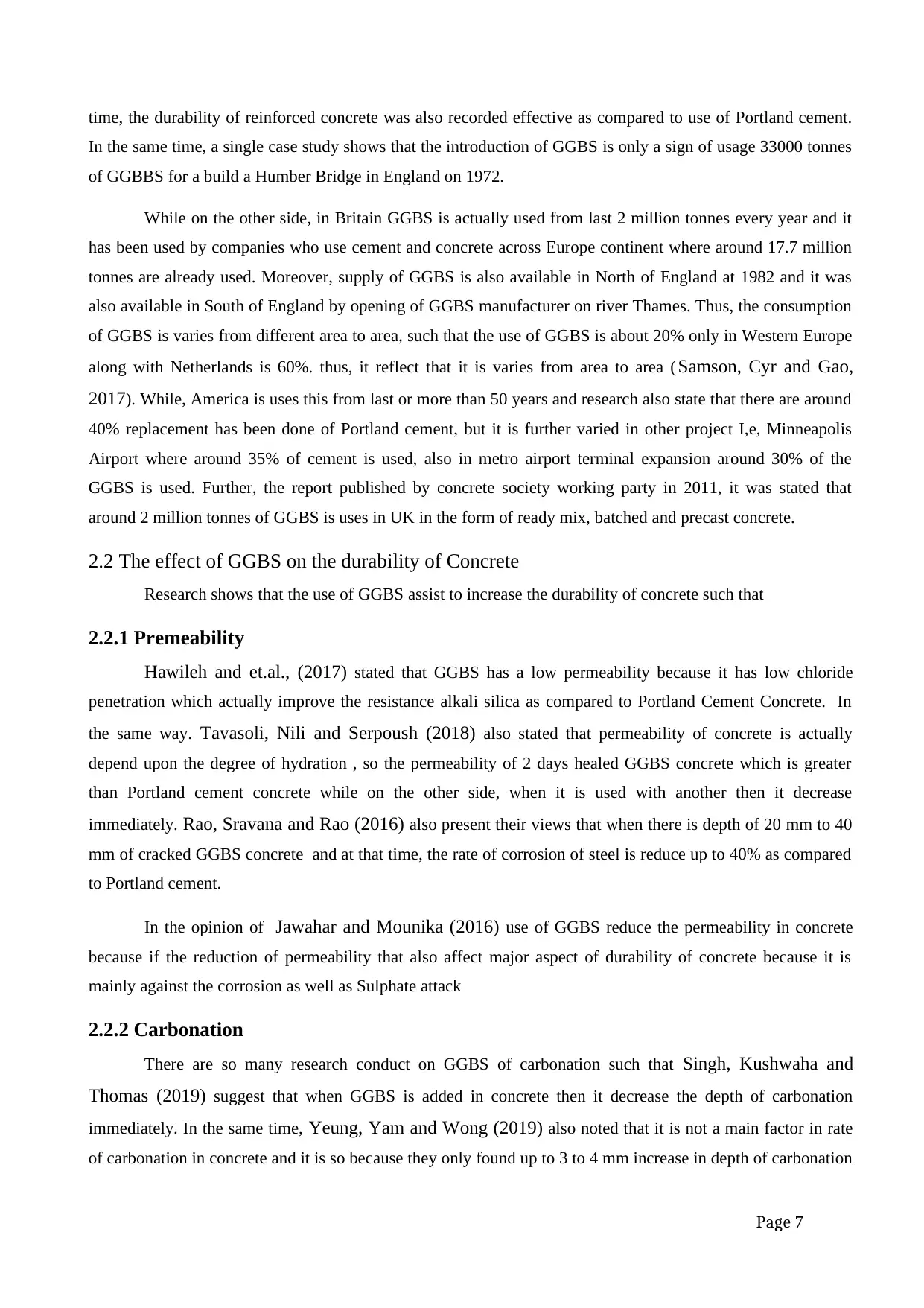
Page 7
time, the durability of reinforced concrete was also recorded effective as compared to use of Portland cement.
In the same time, a single case study shows that the introduction of GGBS is only a sign of usage 33000 tonnes
of GGBBS for a build a Humber Bridge in England on 1972.
While on the other side, in Britain GGBS is actually used from last 2 million tonnes every year and it
has been used by companies who use cement and concrete across Europe continent where around 17.7 million
tonnes are already used. Moreover, supply of GGBS is also available in North of England at 1982 and it was
also available in South of England by opening of GGBS manufacturer on river Thames. Thus, the consumption
of GGBS is varies from different area to area, such that the use of GGBS is about 20% only in Western Europe
along with Netherlands is 60%. thus, it reflect that it is varies from area to area ( Samson, Cyr and Gao,
2017). While, America is uses this from last or more than 50 years and research also state that there are around
40% replacement has been done of Portland cement, but it is further varied in other project I,e, Minneapolis
Airport where around 35% of cement is used, also in metro airport terminal expansion around 30% of the
GGBS is used. Further, the report published by concrete society working party in 2011, it was stated that
around 2 million tonnes of GGBS is uses in UK in the form of ready mix, batched and precast concrete.
2.2 The effect of GGBS on the durability of Concrete
Research shows that the use of GGBS assist to increase the durability of concrete such that
2.2.1 Premeability
Hawileh and et.al., (2017) stated that GGBS has a low permeability because it has low chloride
penetration which actually improve the resistance alkali silica as compared to Portland Cement Concrete. In
the same way. Tavasoli, Nili and Serpoush (2018) also stated that permeability of concrete is actually
depend upon the degree of hydration , so the permeability of 2 days healed GGBS concrete which is greater
than Portland cement concrete while on the other side, when it is used with another then it decrease
immediately. Rao, Sravana and Rao (2016) also present their views that when there is depth of 20 mm to 40
mm of cracked GGBS concrete and at that time, the rate of corrosion of steel is reduce up to 40% as compared
to Portland cement.
In the opinion of Jawahar and Mounika (2016) use of GGBS reduce the permeability in concrete
because if the reduction of permeability that also affect major aspect of durability of concrete because it is
mainly against the corrosion as well as Sulphate attack
2.2.2 Carbonation
There are so many research conduct on GGBS of carbonation such that Singh, Kushwaha and
Thomas (2019) suggest that when GGBS is added in concrete then it decrease the depth of carbonation
immediately. In the same time, Yeung, Yam and Wong (2019) also noted that it is not a main factor in rate
of carbonation in concrete and it is so because they only found up to 3 to 4 mm increase in depth of carbonation
time, the durability of reinforced concrete was also recorded effective as compared to use of Portland cement.
In the same time, a single case study shows that the introduction of GGBS is only a sign of usage 33000 tonnes
of GGBBS for a build a Humber Bridge in England on 1972.
While on the other side, in Britain GGBS is actually used from last 2 million tonnes every year and it
has been used by companies who use cement and concrete across Europe continent where around 17.7 million
tonnes are already used. Moreover, supply of GGBS is also available in North of England at 1982 and it was
also available in South of England by opening of GGBS manufacturer on river Thames. Thus, the consumption
of GGBS is varies from different area to area, such that the use of GGBS is about 20% only in Western Europe
along with Netherlands is 60%. thus, it reflect that it is varies from area to area ( Samson, Cyr and Gao,
2017). While, America is uses this from last or more than 50 years and research also state that there are around
40% replacement has been done of Portland cement, but it is further varied in other project I,e, Minneapolis
Airport where around 35% of cement is used, also in metro airport terminal expansion around 30% of the
GGBS is used. Further, the report published by concrete society working party in 2011, it was stated that
around 2 million tonnes of GGBS is uses in UK in the form of ready mix, batched and precast concrete.
2.2 The effect of GGBS on the durability of Concrete
Research shows that the use of GGBS assist to increase the durability of concrete such that
2.2.1 Premeability
Hawileh and et.al., (2017) stated that GGBS has a low permeability because it has low chloride
penetration which actually improve the resistance alkali silica as compared to Portland Cement Concrete. In
the same way. Tavasoli, Nili and Serpoush (2018) also stated that permeability of concrete is actually
depend upon the degree of hydration , so the permeability of 2 days healed GGBS concrete which is greater
than Portland cement concrete while on the other side, when it is used with another then it decrease
immediately. Rao, Sravana and Rao (2016) also present their views that when there is depth of 20 mm to 40
mm of cracked GGBS concrete and at that time, the rate of corrosion of steel is reduce up to 40% as compared
to Portland cement.
In the opinion of Jawahar and Mounika (2016) use of GGBS reduce the permeability in concrete
because if the reduction of permeability that also affect major aspect of durability of concrete because it is
mainly against the corrosion as well as Sulphate attack
2.2.2 Carbonation
There are so many research conduct on GGBS of carbonation such that Singh, Kushwaha and
Thomas (2019) suggest that when GGBS is added in concrete then it decrease the depth of carbonation
immediately. In the same time, Yeung, Yam and Wong (2019) also noted that it is not a main factor in rate
of carbonation in concrete and it is so because they only found up to 3 to 4 mm increase in depth of carbonation
Paraphrase This Document
Need a fresh take? Get an instant paraphrase of this document with our AI Paraphraser
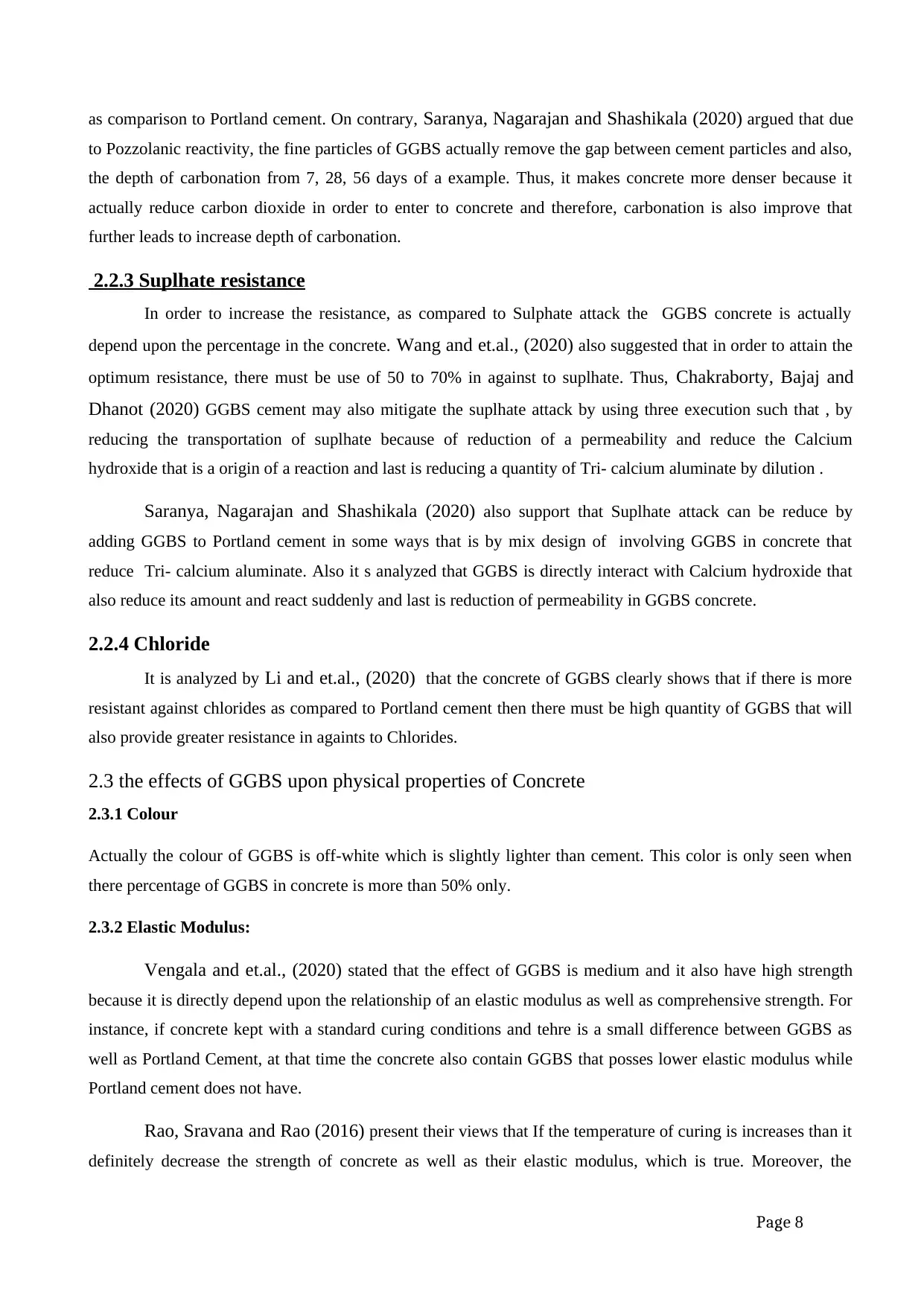
Page 8
as comparison to Portland cement. On contrary, Saranya, Nagarajan and Shashikala (2020) argued that due
to Pozzolanic reactivity, the fine particles of GGBS actually remove the gap between cement particles and also,
the depth of carbonation from 7, 28, 56 days of a example. Thus, it makes concrete more denser because it
actually reduce carbon dioxide in order to enter to concrete and therefore, carbonation is also improve that
further leads to increase depth of carbonation.
2.2.3 Suplhate resistance
In order to increase the resistance, as compared to Sulphate attack the GGBS concrete is actually
depend upon the percentage in the concrete. Wang and et.al., (2020) also suggested that in order to attain the
optimum resistance, there must be use of 50 to 70% in against to suplhate. Thus, Chakraborty, Bajaj and
Dhanot (2020) GGBS cement may also mitigate the suplhate attack by using three execution such that , by
reducing the transportation of suplhate because of reduction of a permeability and reduce the Calcium
hydroxide that is a origin of a reaction and last is reducing a quantity of Tri- calcium aluminate by dilution .
Saranya, Nagarajan and Shashikala (2020) also support that Suplhate attack can be reduce by
adding GGBS to Portland cement in some ways that is by mix design of involving GGBS in concrete that
reduce Tri- calcium aluminate. Also it s analyzed that GGBS is directly interact with Calcium hydroxide that
also reduce its amount and react suddenly and last is reduction of permeability in GGBS concrete.
2.2.4 Chloride
It is analyzed by Li and et.al., (2020) that the concrete of GGBS clearly shows that if there is more
resistant against chlorides as compared to Portland cement then there must be high quantity of GGBS that will
also provide greater resistance in againts to Chlorides.
2.3 the effects of GGBS upon physical properties of Concrete
2.3.1 Colour
Actually the colour of GGBS is off-white which is slightly lighter than cement. This color is only seen when
there percentage of GGBS in concrete is more than 50% only.
2.3.2 Elastic Modulus:
Vengala and et.al., (2020) stated that the effect of GGBS is medium and it also have high strength
because it is directly depend upon the relationship of an elastic modulus as well as comprehensive strength. For
instance, if concrete kept with a standard curing conditions and tehre is a small difference between GGBS as
well as Portland Cement, at that time the concrete also contain GGBS that posses lower elastic modulus while
Portland cement does not have.
Rao, Sravana and Rao (2016) present their views that If the temperature of curing is increases than it
definitely decrease the strength of concrete as well as their elastic modulus, which is true. Moreover, the
as comparison to Portland cement. On contrary, Saranya, Nagarajan and Shashikala (2020) argued that due
to Pozzolanic reactivity, the fine particles of GGBS actually remove the gap between cement particles and also,
the depth of carbonation from 7, 28, 56 days of a example. Thus, it makes concrete more denser because it
actually reduce carbon dioxide in order to enter to concrete and therefore, carbonation is also improve that
further leads to increase depth of carbonation.
2.2.3 Suplhate resistance
In order to increase the resistance, as compared to Sulphate attack the GGBS concrete is actually
depend upon the percentage in the concrete. Wang and et.al., (2020) also suggested that in order to attain the
optimum resistance, there must be use of 50 to 70% in against to suplhate. Thus, Chakraborty, Bajaj and
Dhanot (2020) GGBS cement may also mitigate the suplhate attack by using three execution such that , by
reducing the transportation of suplhate because of reduction of a permeability and reduce the Calcium
hydroxide that is a origin of a reaction and last is reducing a quantity of Tri- calcium aluminate by dilution .
Saranya, Nagarajan and Shashikala (2020) also support that Suplhate attack can be reduce by
adding GGBS to Portland cement in some ways that is by mix design of involving GGBS in concrete that
reduce Tri- calcium aluminate. Also it s analyzed that GGBS is directly interact with Calcium hydroxide that
also reduce its amount and react suddenly and last is reduction of permeability in GGBS concrete.
2.2.4 Chloride
It is analyzed by Li and et.al., (2020) that the concrete of GGBS clearly shows that if there is more
resistant against chlorides as compared to Portland cement then there must be high quantity of GGBS that will
also provide greater resistance in againts to Chlorides.
2.3 the effects of GGBS upon physical properties of Concrete
2.3.1 Colour
Actually the colour of GGBS is off-white which is slightly lighter than cement. This color is only seen when
there percentage of GGBS in concrete is more than 50% only.
2.3.2 Elastic Modulus:
Vengala and et.al., (2020) stated that the effect of GGBS is medium and it also have high strength
because it is directly depend upon the relationship of an elastic modulus as well as comprehensive strength. For
instance, if concrete kept with a standard curing conditions and tehre is a small difference between GGBS as
well as Portland Cement, at that time the concrete also contain GGBS that posses lower elastic modulus while
Portland cement does not have.
Rao, Sravana and Rao (2016) present their views that If the temperature of curing is increases than it
definitely decrease the strength of concrete as well as their elastic modulus, which is true. Moreover, the
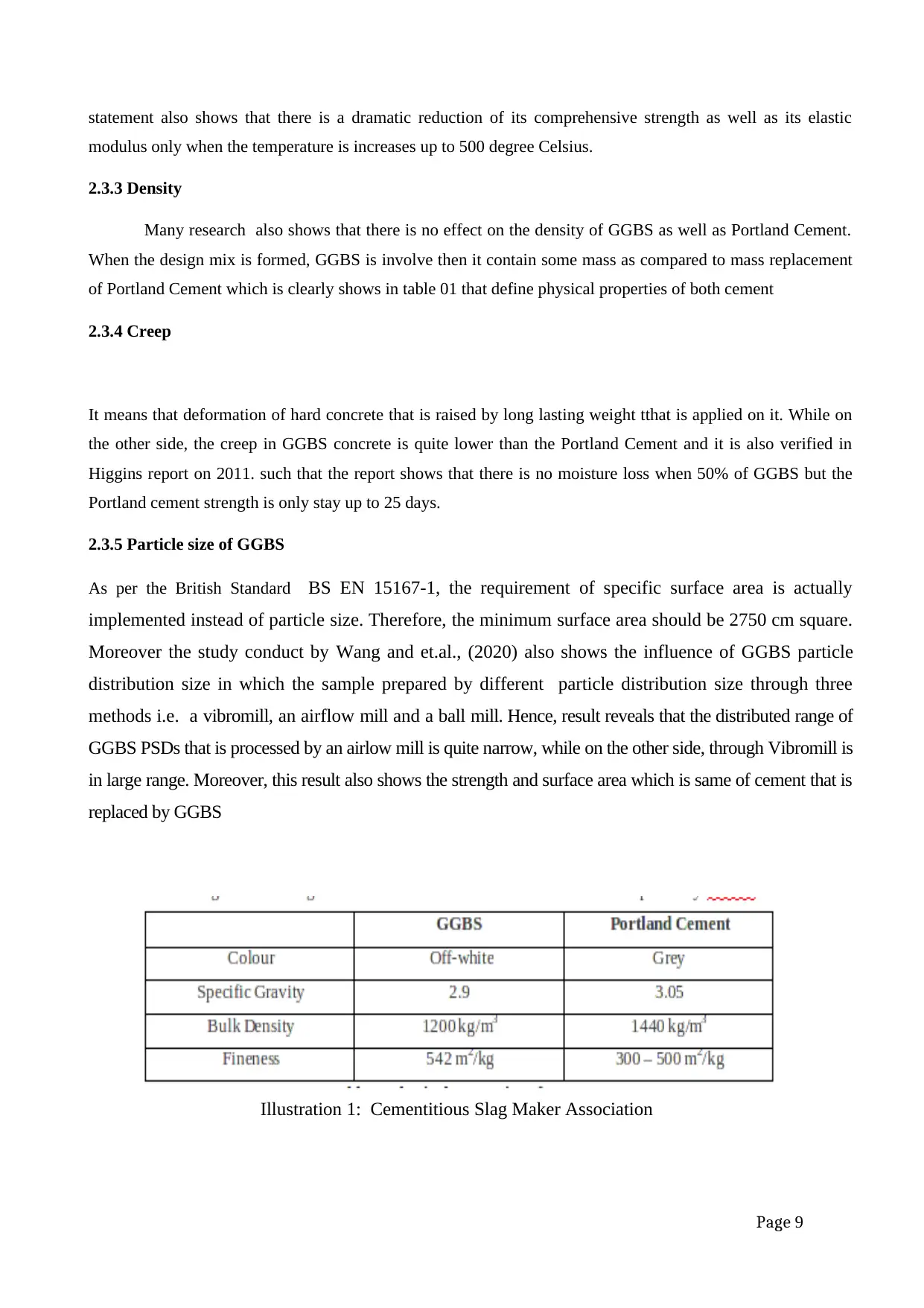
Page 9
statement also shows that there is a dramatic reduction of its comprehensive strength as well as its elastic
modulus only when the temperature is increases up to 500 degree Celsius.
2.3.3 Density
Many research also shows that there is no effect on the density of GGBS as well as Portland Cement.
When the design mix is formed, GGBS is involve then it contain some mass as compared to mass replacement
of Portland Cement which is clearly shows in table 01 that define physical properties of both cement
2.3.4 Creep
It means that deformation of hard concrete that is raised by long lasting weight tthat is applied on it. While on
the other side, the creep in GGBS concrete is quite lower than the Portland Cement and it is also verified in
Higgins report on 2011. such that the report shows that there is no moisture loss when 50% of GGBS but the
Portland cement strength is only stay up to 25 days.
2.3.5 Particle size of GGBS
As per the British Standard BS EN 15167-1, the requirement of specific surface area is actually
implemented instead of particle size. Therefore, the minimum surface area should be 2750 cm square.
Moreover the study conduct by Wang and et.al., (2020) also shows the influence of GGBS particle
distribution size in which the sample prepared by different particle distribution size through three
methods i.e. a vibromill, an airflow mill and a ball mill. Hence, result reveals that the distributed range of
GGBS PSDs that is processed by an airlow mill is quite narrow, while on the other side, through Vibromill is
in large range. Moreover, this result also shows the strength and surface area which is same of cement that is
replaced by GGBS
Illustration 1: Cementitious Slag Maker Association
statement also shows that there is a dramatic reduction of its comprehensive strength as well as its elastic
modulus only when the temperature is increases up to 500 degree Celsius.
2.3.3 Density
Many research also shows that there is no effect on the density of GGBS as well as Portland Cement.
When the design mix is formed, GGBS is involve then it contain some mass as compared to mass replacement
of Portland Cement which is clearly shows in table 01 that define physical properties of both cement
2.3.4 Creep
It means that deformation of hard concrete that is raised by long lasting weight tthat is applied on it. While on
the other side, the creep in GGBS concrete is quite lower than the Portland Cement and it is also verified in
Higgins report on 2011. such that the report shows that there is no moisture loss when 50% of GGBS but the
Portland cement strength is only stay up to 25 days.
2.3.5 Particle size of GGBS
As per the British Standard BS EN 15167-1, the requirement of specific surface area is actually
implemented instead of particle size. Therefore, the minimum surface area should be 2750 cm square.
Moreover the study conduct by Wang and et.al., (2020) also shows the influence of GGBS particle
distribution size in which the sample prepared by different particle distribution size through three
methods i.e. a vibromill, an airflow mill and a ball mill. Hence, result reveals that the distributed range of
GGBS PSDs that is processed by an airlow mill is quite narrow, while on the other side, through Vibromill is
in large range. Moreover, this result also shows the strength and surface area which is same of cement that is
replaced by GGBS
Illustration 1: Cementitious Slag Maker Association
⊘ This is a preview!⊘
Do you want full access?
Subscribe today to unlock all pages.

Trusted by 1+ million students worldwide

Page 10
2.4 GGBS effect on chemical Properties of concrete:
2.4.1 Alkali and Silica reaction (ASR)
It is known as a chemical reaction between hyrodxyl ions in pore water and some forms of silica which
is takes place in an aggregate is known as ASR. At global level, the GGBS is also known as a material that is
used to reduce the risk of damage that is generally form due to ASR. Also, many researcher also confirm that
there is no concrete structure that posses 35% or more than it and also there is no need to taken account of
ASR when there is 40% or more than GGBS uses in it.
2.4.2 Chemical reaction of GGBS:
As per the Almeida and Klemm (2017) GGBS is somehow related to the Portland cement
which is mixed with water and then released the calcium hydroxide. In relation to comparing with the
Portland cement, they carried to be stronger and thinner and also easily absorb in the cement to make
it harder and also much higher chemical stability than the other cement. Thus, such stability is also
sanctioned by the Cementitious slag Association. It is also stated that the BS6699 explained the
consistency of the GGBS in proportionate to the increase of the amount of CaO, MgO but the ratio of
the GGBS decreased in respect of increase in SiO (Al-Oran, Safiee and Nasir, 2019).
2.5 The effects of GGBS on other aspects:
Due to considering the fineness and crush materials of sand, the effects of GGBS arises due to
undertaking the following aspects such as:
2.4 GGBS effect on chemical Properties of concrete:
2.4.1 Alkali and Silica reaction (ASR)
It is known as a chemical reaction between hyrodxyl ions in pore water and some forms of silica which
is takes place in an aggregate is known as ASR. At global level, the GGBS is also known as a material that is
used to reduce the risk of damage that is generally form due to ASR. Also, many researcher also confirm that
there is no concrete structure that posses 35% or more than it and also there is no need to taken account of
ASR when there is 40% or more than GGBS uses in it.
2.4.2 Chemical reaction of GGBS:
As per the Almeida and Klemm (2017) GGBS is somehow related to the Portland cement
which is mixed with water and then released the calcium hydroxide. In relation to comparing with the
Portland cement, they carried to be stronger and thinner and also easily absorb in the cement to make
it harder and also much higher chemical stability than the other cement. Thus, such stability is also
sanctioned by the Cementitious slag Association. It is also stated that the BS6699 explained the
consistency of the GGBS in proportionate to the increase of the amount of CaO, MgO but the ratio of
the GGBS decreased in respect of increase in SiO (Al-Oran, Safiee and Nasir, 2019).
2.5 The effects of GGBS on other aspects:
Due to considering the fineness and crush materials of sand, the effects of GGBS arises due to
undertaking the following aspects such as:
Paraphrase This Document
Need a fresh take? Get an instant paraphrase of this document with our AI Paraphraser
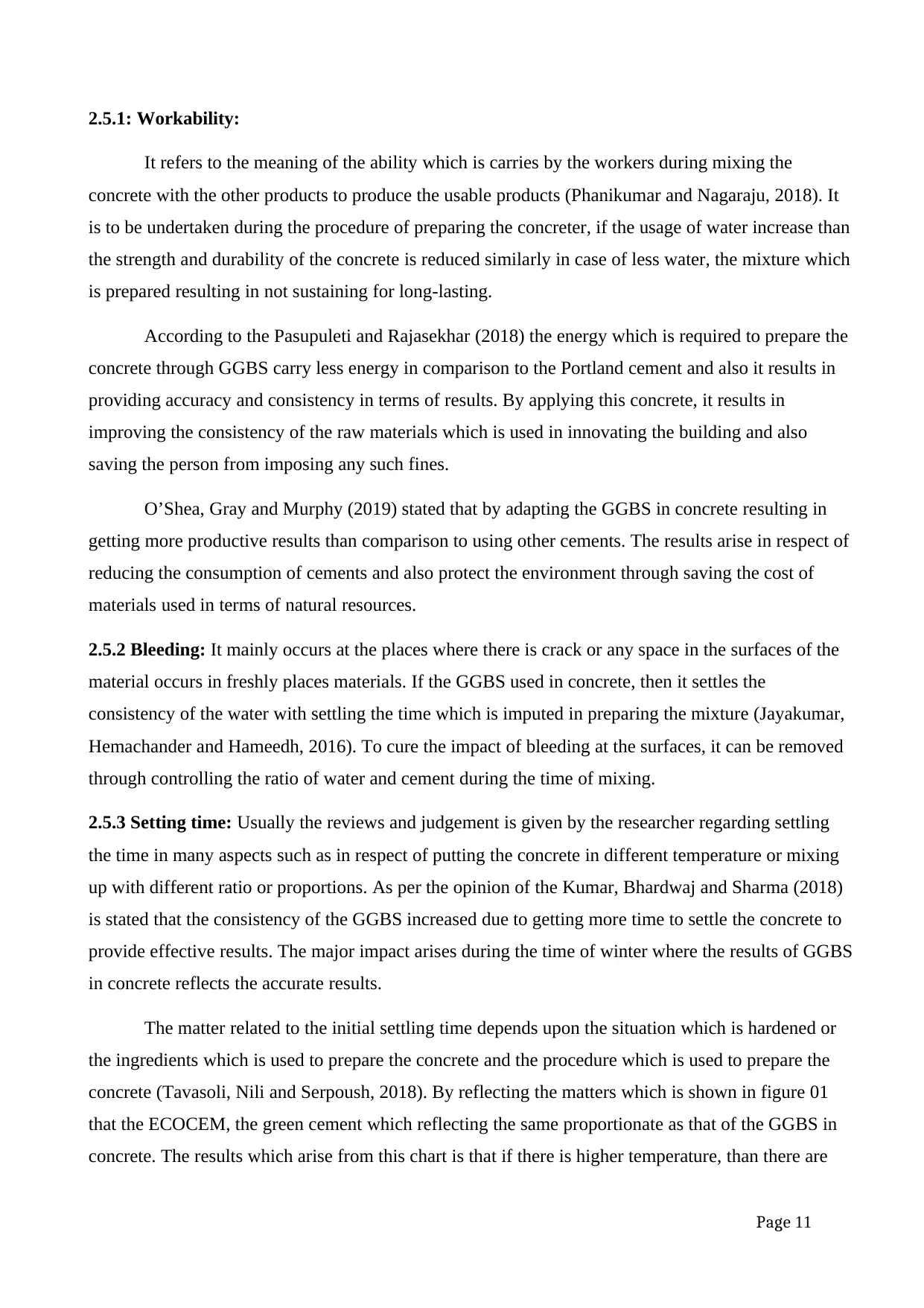
Page 11
2.5.1: Workability:
It refers to the meaning of the ability which is carries by the workers during mixing the
concrete with the other products to produce the usable products (Phanikumar and Nagaraju, 2018). It
is to be undertaken during the procedure of preparing the concreter, if the usage of water increase than
the strength and durability of the concrete is reduced similarly in case of less water, the mixture which
is prepared resulting in not sustaining for long-lasting.
According to the Pasupuleti and Rajasekhar (2018) the energy which is required to prepare the
concrete through GGBS carry less energy in comparison to the Portland cement and also it results in
providing accuracy and consistency in terms of results. By applying this concrete, it results in
improving the consistency of the raw materials which is used in innovating the building and also
saving the person from imposing any such fines.
O’Shea, Gray and Murphy (2019) stated that by adapting the GGBS in concrete resulting in
getting more productive results than comparison to using other cements. The results arise in respect of
reducing the consumption of cements and also protect the environment through saving the cost of
materials used in terms of natural resources.
2.5.2 Bleeding: It mainly occurs at the places where there is crack or any space in the surfaces of the
material occurs in freshly places materials. If the GGBS used in concrete, then it settles the
consistency of the water with settling the time which is imputed in preparing the mixture (Jayakumar,
Hemachander and Hameedh, 2016). To cure the impact of bleeding at the surfaces, it can be removed
through controlling the ratio of water and cement during the time of mixing.
2.5.3 Setting time: Usually the reviews and judgement is given by the researcher regarding settling
the time in many aspects such as in respect of putting the concrete in different temperature or mixing
up with different ratio or proportions. As per the opinion of the Kumar, Bhardwaj and Sharma (2018)
is stated that the consistency of the GGBS increased due to getting more time to settle the concrete to
provide effective results. The major impact arises during the time of winter where the results of GGBS
in concrete reflects the accurate results.
The matter related to the initial settling time depends upon the situation which is hardened or
the ingredients which is used to prepare the concrete and the procedure which is used to prepare the
concrete (Tavasoli, Nili and Serpoush, 2018). By reflecting the matters which is shown in figure 01
that the ECOCEM, the green cement which reflecting the same proportionate as that of the GGBS in
concrete. The results which arise from this chart is that if there is higher temperature, than there are
2.5.1: Workability:
It refers to the meaning of the ability which is carries by the workers during mixing the
concrete with the other products to produce the usable products (Phanikumar and Nagaraju, 2018). It
is to be undertaken during the procedure of preparing the concreter, if the usage of water increase than
the strength and durability of the concrete is reduced similarly in case of less water, the mixture which
is prepared resulting in not sustaining for long-lasting.
According to the Pasupuleti and Rajasekhar (2018) the energy which is required to prepare the
concrete through GGBS carry less energy in comparison to the Portland cement and also it results in
providing accuracy and consistency in terms of results. By applying this concrete, it results in
improving the consistency of the raw materials which is used in innovating the building and also
saving the person from imposing any such fines.
O’Shea, Gray and Murphy (2019) stated that by adapting the GGBS in concrete resulting in
getting more productive results than comparison to using other cements. The results arise in respect of
reducing the consumption of cements and also protect the environment through saving the cost of
materials used in terms of natural resources.
2.5.2 Bleeding: It mainly occurs at the places where there is crack or any space in the surfaces of the
material occurs in freshly places materials. If the GGBS used in concrete, then it settles the
consistency of the water with settling the time which is imputed in preparing the mixture (Jayakumar,
Hemachander and Hameedh, 2016). To cure the impact of bleeding at the surfaces, it can be removed
through controlling the ratio of water and cement during the time of mixing.
2.5.3 Setting time: Usually the reviews and judgement is given by the researcher regarding settling
the time in many aspects such as in respect of putting the concrete in different temperature or mixing
up with different ratio or proportions. As per the opinion of the Kumar, Bhardwaj and Sharma (2018)
is stated that the consistency of the GGBS increased due to getting more time to settle the concrete to
provide effective results. The major impact arises during the time of winter where the results of GGBS
in concrete reflects the accurate results.
The matter related to the initial settling time depends upon the situation which is hardened or
the ingredients which is used to prepare the concrete and the procedure which is used to prepare the
concrete (Tavasoli, Nili and Serpoush, 2018). By reflecting the matters which is shown in figure 01
that the ECOCEM, the green cement which reflecting the same proportionate as that of the GGBS in
concrete. The results which arise from this chart is that if there is higher temperature, than there are
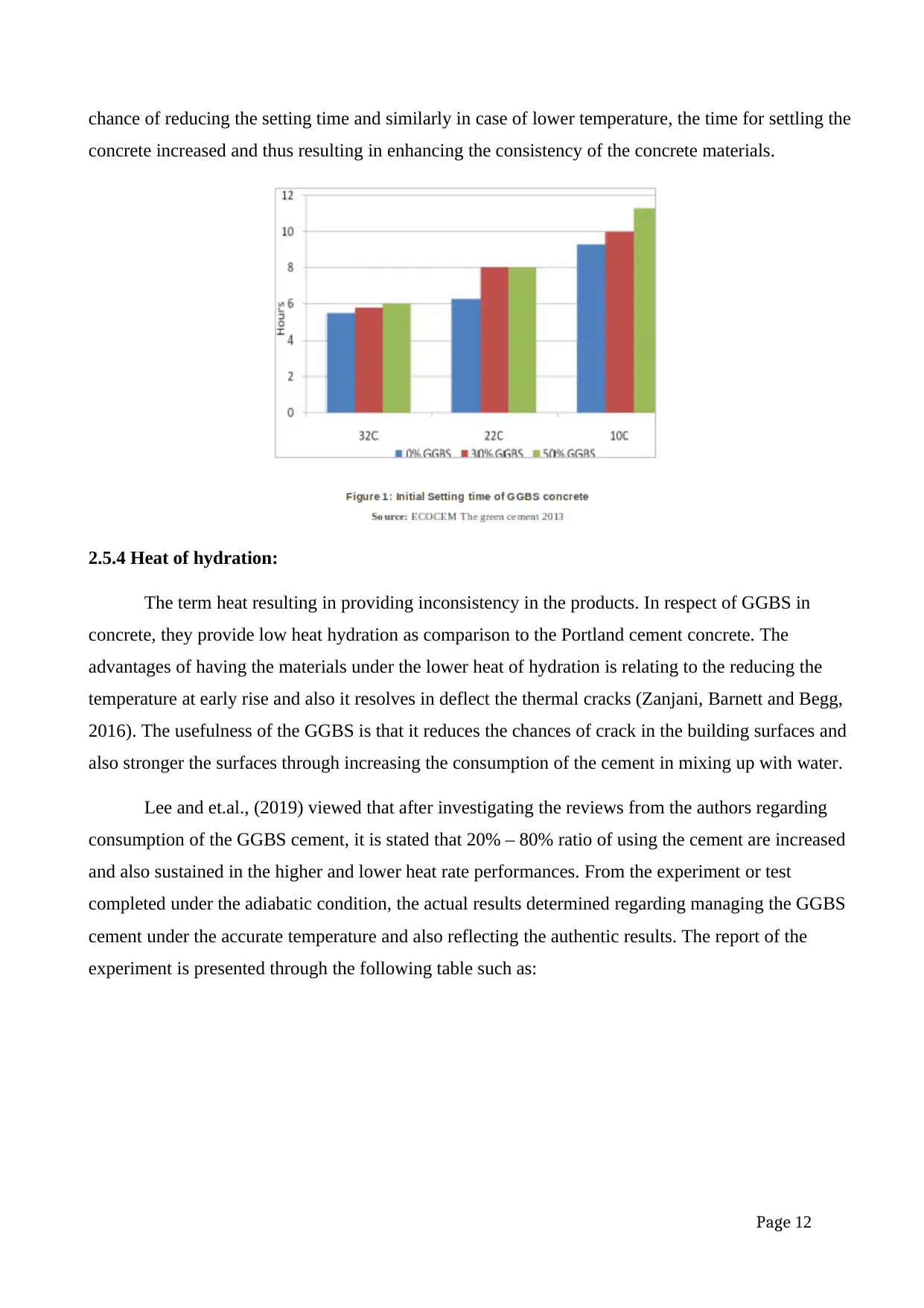
Page 12
chance of reducing the setting time and similarly in case of lower temperature, the time for settling the
concrete increased and thus resulting in enhancing the consistency of the concrete materials.
2.5.4 Heat of hydration:
The term heat resulting in providing inconsistency in the products. In respect of GGBS in
concrete, they provide low heat hydration as comparison to the Portland cement concrete. The
advantages of having the materials under the lower heat of hydration is relating to the reducing the
temperature at early rise and also it resolves in deflect the thermal cracks (Zanjani, Barnett and Begg,
2016). The usefulness of the GGBS is that it reduces the chances of crack in the building surfaces and
also stronger the surfaces through increasing the consumption of the cement in mixing up with water.
Lee and et.al., (2019) viewed that after investigating the reviews from the authors regarding
consumption of the GGBS cement, it is stated that 20% – 80% ratio of using the cement are increased
and also sustained in the higher and lower heat rate performances. From the experiment or test
completed under the adiabatic condition, the actual results determined regarding managing the GGBS
cement under the accurate temperature and also reflecting the authentic results. The report of the
experiment is presented through the following table such as:
chance of reducing the setting time and similarly in case of lower temperature, the time for settling the
concrete increased and thus resulting in enhancing the consistency of the concrete materials.
2.5.4 Heat of hydration:
The term heat resulting in providing inconsistency in the products. In respect of GGBS in
concrete, they provide low heat hydration as comparison to the Portland cement concrete. The
advantages of having the materials under the lower heat of hydration is relating to the reducing the
temperature at early rise and also it resolves in deflect the thermal cracks (Zanjani, Barnett and Begg,
2016). The usefulness of the GGBS is that it reduces the chances of crack in the building surfaces and
also stronger the surfaces through increasing the consumption of the cement in mixing up with water.
Lee and et.al., (2019) viewed that after investigating the reviews from the authors regarding
consumption of the GGBS cement, it is stated that 20% – 80% ratio of using the cement are increased
and also sustained in the higher and lower heat rate performances. From the experiment or test
completed under the adiabatic condition, the actual results determined regarding managing the GGBS
cement under the accurate temperature and also reflecting the authentic results. The report of the
experiment is presented through the following table such as:
⊘ This is a preview!⊘
Do you want full access?
Subscribe today to unlock all pages.

Trusted by 1+ million students worldwide
1 out of 43
Related Documents
Your All-in-One AI-Powered Toolkit for Academic Success.
+13062052269
info@desklib.com
Available 24*7 on WhatsApp / Email
![[object Object]](/_next/static/media/star-bottom.7253800d.svg)
Unlock your academic potential
Copyright © 2020–2025 A2Z Services. All Rights Reserved. Developed and managed by ZUCOL.





